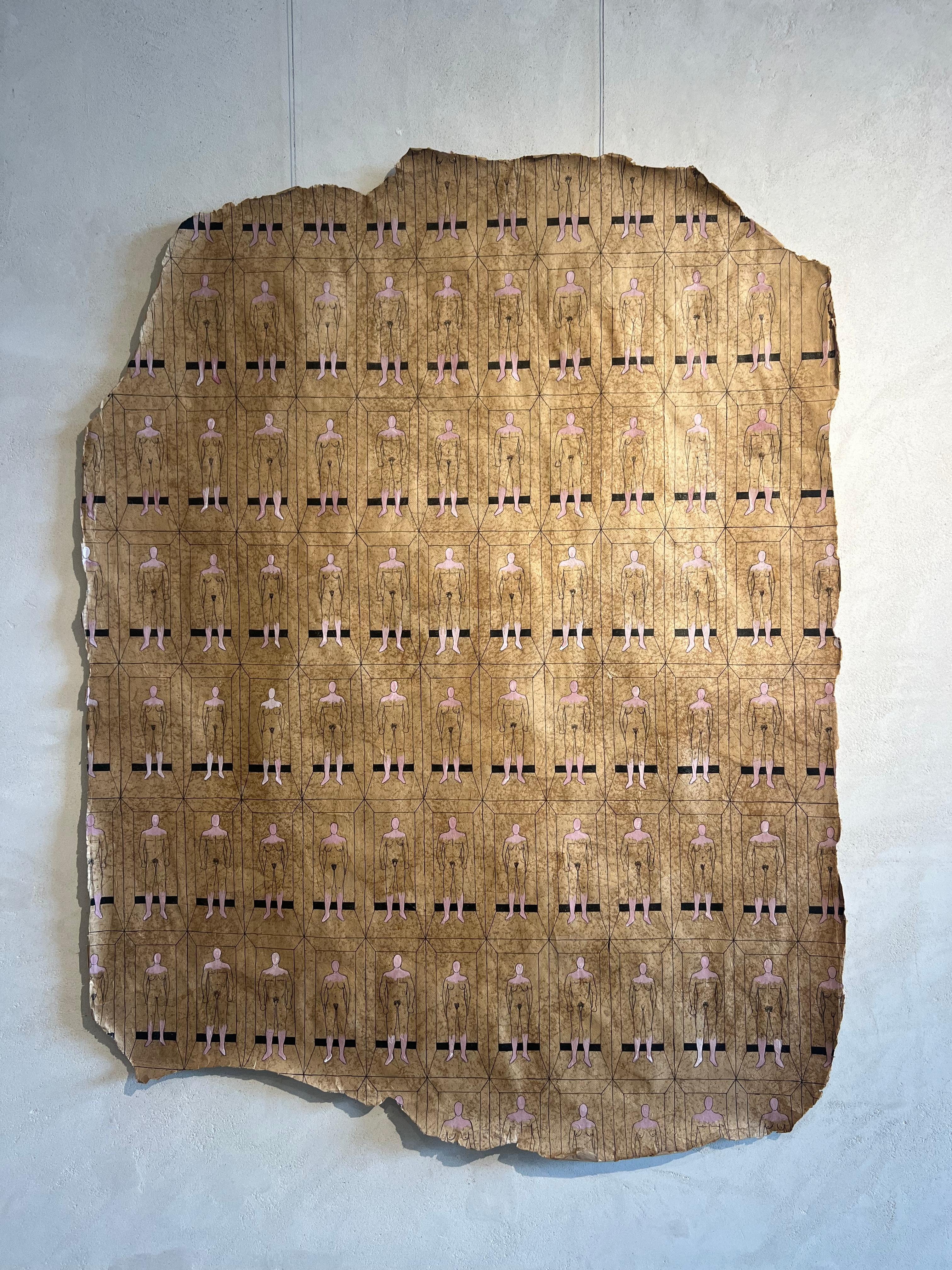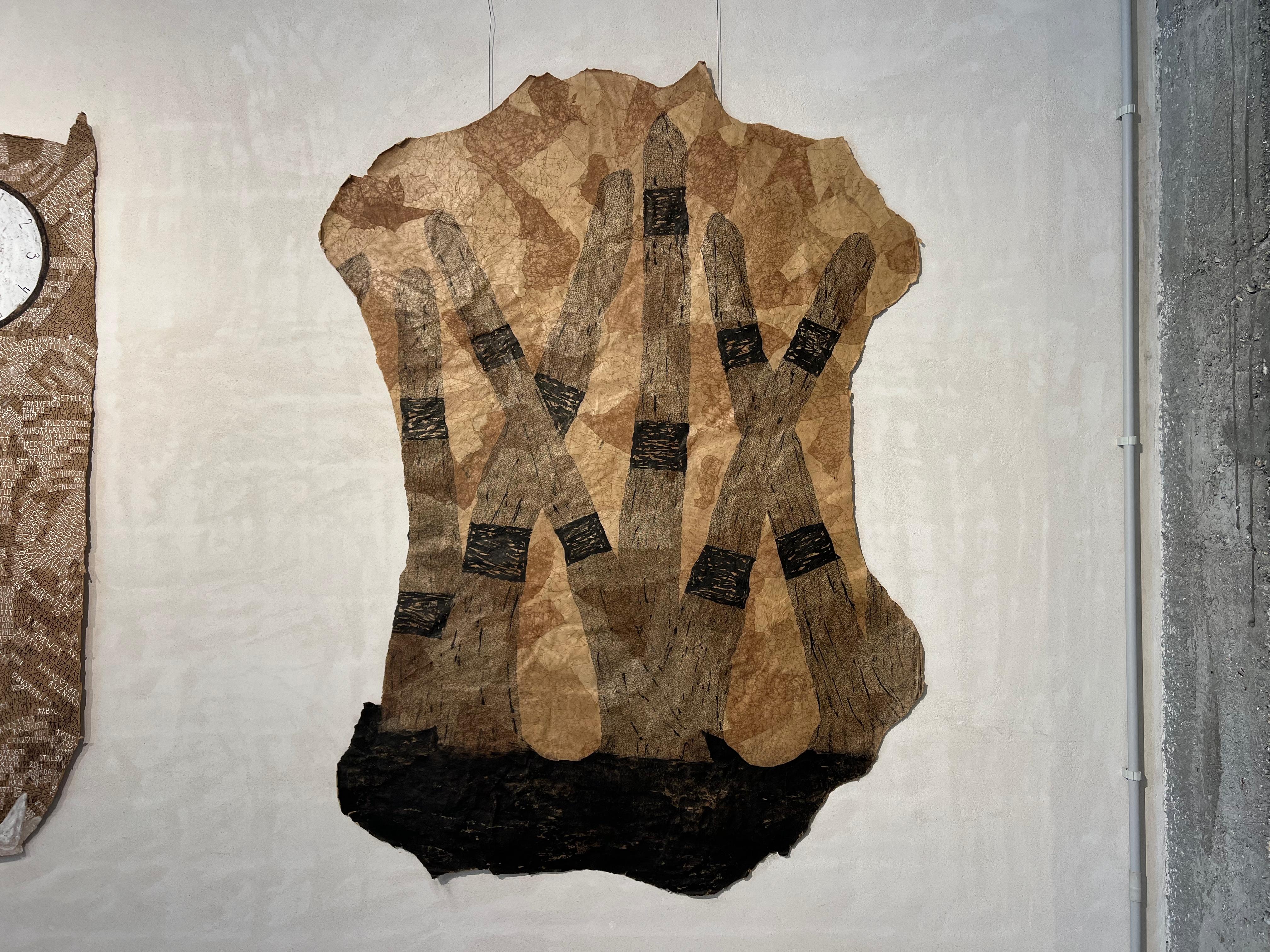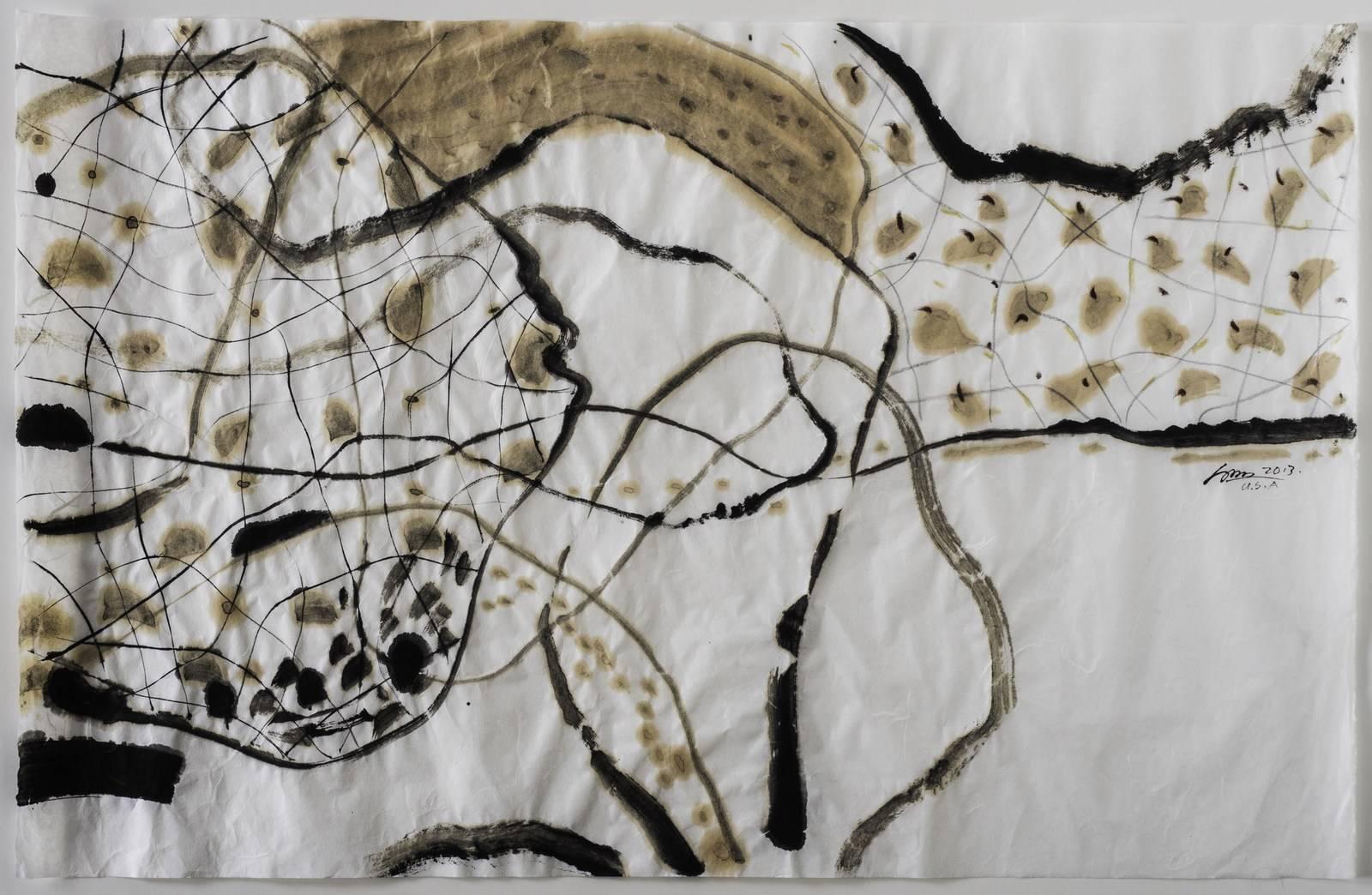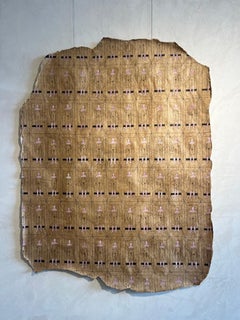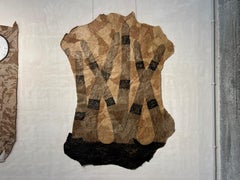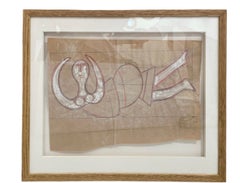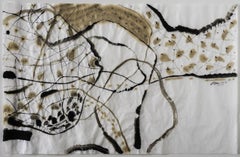Items Similar to Primitive drawings on paper, hand-drawn Chinese ink, three thousand portraits
Want more images or videos?
Request additional images or videos from the seller
1 of 7
Peter KramerPrimitive drawings on paper, hand-drawn Chinese ink, three thousand portraits1992
1992
$4,030.16
£3,018.28
€3,400
CA$5,649.28
A$6,224.19
CHF 3,222.02
MX$74,940.89
NOK 40,798.55
SEK 38,327.66
DKK 25,892.99
About the Item
Obsessive, meticulous, almost monastic, Kramer immerses us in a universe of graphic and sculptural repetitions. His drawings on kraft paper glued with rabbit glue recall both ancient codices and tanned hides. In them, numbers, faces, and symbols are repeated hundreds of times, generating an overwhelming visual rhythm. Added to this are his sculptures of dictionaries altered word by word until they become egg-shaped structures: symbols of origin, contained knowledge, and untapped potential. In another series, Peter uses cotton knots, an ancient technique with which he constructs pieces of structural tension and tactile sensitivity. His work is reminiscent of Hanne Darboven's for its obsessive component and Eva Hesse's for its soft material and intimate gesture. It is a work that forces the viewer to pause, to look closely, to inhabit the time of manual labor.
The work measures 130 x 110 cm. In total, there are more than 3,200 portraits, hand-drawn with India ink on paper. The work is part of the exhibition "The future will be prehistoric" at the Manolo Eirin Gallery.
- Creator:Peter Kramer (1959, Danish)
- Creation Year:1992
- Dimensions:Height: 51.19 in (130 cm)Width: 43.31 in (110 cm)Depth: 0.4 in (1 cm)
- Medium:
- Movement & Style:
- Period:
- Condition:
- Gallery Location:Carballo, ES
- Reference Number:1stDibs: LU2117216551432
About the Seller
5.0
Vetted Professional Seller
Every seller passes strict standards for authenticity and reliability
1stDibs seller since 2022
16 sales on 1stDibs
- ShippingRetrieving quote...Shipping from: Carballo, Spain
- Return Policy
Authenticity Guarantee
In the unlikely event there’s an issue with an item’s authenticity, contact us within 1 year for a full refund. DetailsMoney-Back Guarantee
If your item is not as described, is damaged in transit, or does not arrive, contact us within 7 days for a full refund. Details24-Hour Cancellation
You have a 24-hour grace period in which to reconsider your purchase, with no questions asked.Vetted Professional Sellers
Our world-class sellers must adhere to strict standards for service and quality, maintaining the integrity of our listings.Price-Match Guarantee
If you find that a seller listed the same item for a lower price elsewhere, we’ll match it.Trusted Global Delivery
Our best-in-class carrier network provides specialized shipping options worldwide, including custom delivery.More From This Seller
View AllCave paintings on paper, Indian ink, hand drawing, leather papyrus style
Located in Carballo, ES
Obsessive, meticulous, almost monastic, Kramer immerses us in a universe of graphic and sculptural repetitions. His drawings on kraft paper glued with rabbit glue recall both ancient...
Category
21st Century and Contemporary Conceptual Figurative Paintings
Materials
Ink, Handmade Paper
Chinese ink painting made with thousands of numbers, natural black, brown
Located in Carballo, ES
Obsessive, meticulous, almost monastic, Kramer immerses us in a universe of graphic and sculptural repetitions. His drawings on kraft paper glued with rabbit glue recall both ancient...
Category
21st Century and Contemporary Conceptual Portrait Drawings and Watercolors
Materials
Ink, Handmade Paper
Painting on paper, lyrical abstraction, contemporary, music score
Located in Carballo, ES
Blue Minimal Painting. This is an original artwork realized by TUSET in 2019. We can frame it in natural wood or black on request. The dimensions of the painting are 41 x 29,5 cm. W...
Category
21st Century and Contemporary Conceptual Landscape Drawings and Watercolors
Materials
Ink, Handmade Paper
Painting on paper, lyrical abstraction, contemporary, music score
Located in Carballo, ES
Blue Minimal Painting. This is an original artwork realized by TUSET in 2019. We can frame it in natural wood or black on request. The dimensions of the painting are 41 x 29,5 cm. W...
Category
21st Century and Contemporary Abstract Expressionist Landscape Drawings ...
Materials
Ink, Handmade Paper
Original ink on Paper, Contemporary Abstract Expressionist
Located in Carballo, ES
Black And White Minimal Painting is an original artwork realized by TUSET in 2020. The painting is unframed, we can frame it in natural wood or black on request.
The title of this w...
Category
21st Century and Contemporary Neo-Expressionist Abstract Paintings
Materials
Ink, Handmade Paper
Original ink on Paper, Contemporary Abstract Expressionist
Located in Carballo, ES
Black And White Minimal Painting is an original artwork realized by TUSET in 2020. The painting is unframed, we can frame it in natural wood or black on request.
The title of this ...
Category
21st Century and Contemporary Abstract Expressionist Abstract Drawings a...
Materials
Ink, Handmade Paper
You May Also Like
Untitled (Inspired by a Chinese scroll painting)
By Peter Marks
Located in Fairlawn, OH
Untitled (Inspired by a Chinese scroll painting)
Collage with ink on 6 paper elements
Unsigned
Provenance: Estate of the Artist
Condition: Excellent
Image size: 4 x 12 inches
Support...
Category
Early 2000s Abstract Abstract Drawings and Watercolors
Materials
Ink
Dessin préparatoire
Located in PARIS, FR
Preparatory drawing by Roger Capron in acrylic pencil on craft paper.
Roger Capron, a French ceramist, discovered ceramics in 1946 in Vallauris, where he founded the Callis workshop....
Category
20th Century Figurative Drawings and Watercolors
Materials
Pencil
Untitled II
By Bai Ming
Located in Kansas City, MO
Bai Ming, is a famous contemporary ceramic artist and painter born in September 1965 in Yugan, Jiangxi Province of China.
•Director of the Department of Ceramic Art in the Academy of Arts & Design of Tsinghua University.
•Executive Vice Director of the Art Museum in the Academy of Arts & Design, Tsinghua University
•Member of the International Academy of Ceramics (IAC) of UNESCO.
•Secretary-General of the Ceramic Art Council of China Artists Association (CAA).
•Deputy Director of Ceramic Art Institute,China National Academy of Painting.
•Member of China Oil Painting Society (COPS).
•Art Director of China Ceramic Art Net
•Executive Editor of Chinese Ceramist magazine.
•Director of “Shangyu Celadon” Contemporary International Ceramic Art Center.
In 1998, the organizers of the Taipei International Art Fair held the joint exhibition of Bai Ming’s and Picasso’s ceramic works named “Vallauris in France & Jingdezhen in China”.
•In 2000, he was honored with the gold prize of The Invitational Exhibition of China Young Ceramic Artists.
•In 2004, he was awarded for Contribution to Promotion of the Contemporary Ceramic Art of China in the Great Hall of the People.
•Also in 2004, the book Jingdezhen Traditional Ceramic-Making Techniques which written by Bai Ming received the National Book Award.
In 2010, at the invitation of IAC, Chinese Cultural Center in Paris and Confucius Institute of Poitiers University, he held the “Oriental Ceramic Story—Bai Ming Ceramic...
Category
2010s Abstract Animal Paintings
Materials
Ink, Handmade Paper
$1,499 Sale Price
58% Off
Chinese Contemporary Art by Xia FuNing - Not See, Not Know
By Xia FuNing
Located in Paris, IDF
Oil on paper
Xia Fu-Ning is a Chinese artist born in 1962 in Nanjing. He was a professor in the Department of Fine Arts during the 1980s at Tianjin Polytechnic University. He curren...
Category
2010s Contemporary Abstract Drawings and Watercolors
Materials
Paper, Oil
Drawings, Figurative, Ink on Paper, Two sided work by Indra Dugar "In Stock"
By Indra Dugar
Located in Kolkata, West Bengal
Indra Dugar - Untitled - 8 x 10.5 inches (unframed size) & 16 x 18.5 inches ( framed size )
This is a two sided works, Recto & Verso. Set of 4 art works.
Ink on Paper.
Inclusive of shipment in framed form.
Style : Dugar was known for his paintings of rustic scenes en plein air, painted in a non-academic style, yet retaining colour harmony to reflect the tranquillity of his subject matter. He learnt how to structure his landscapes from Nirode Mazumdar and Rathin Moitra, and from his father, he inherited the tradition of painting on silk. Watercolour and tempera were his preferred media. Dugar's earlier works leaned heavily on his observations, but he gradually began paring down detail.
Dugar soon outgrew the Bengal School...
Category
1960s Modern Figurative Drawings and Watercolors
Materials
Paper, Ink, India Ink, Ballpoint Pen
Dessin préparatoire
Located in PARIS, FR
Preparatory drawing by Roger Capron in acrylic pencil on craft paper
Roger Capron, a French ceramist, discovered ceramics in 1946 in Vallauris, where he founded the Callis workshop. ...
Category
20th Century Animal Drawings and Watercolors
Materials
Pencil
More Ways To Browse
Eva Hesse
Peter Cotton
Peter Kramer
Emerging Artists
Antique Salon
The New York Times Magazine
Oil Paintings With Gold Frames
Pink Paintings
Original Vintage Oil Painting Framed Paintings
Vintage Marchal
Tree Art
Vintage Catalogs
Yellow Painting
Blue Landscape Painting
Art Institute Of Chicago
Vintage Painting Signed Paintings
Impressionist Paintings Of New York
19th Century Signed Oil Painting
